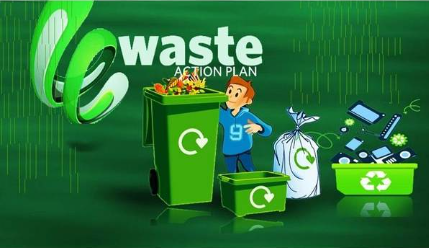Electronic waste or e-waste is now fast becoming an important environment issue for the world. It is the waste generated from electronic, electrical appliances and IT sector. It consists of items such as discarded mobiles, computer systems and their peripherals, old CDs, household and kitchen appliances, washing machines, medical equipment, transceivers, TVs, iPods, refrigerators and air conditioners etc.
Modern technological advancements and digital revolution have led to a massive infiltration of smart gadgets, electronic and electrical appliances into our lives. As the technology keeps on getting update the products become obsolete faster, new replace the old, thus generating toxic e-waste at a much higher rate. The challenge for the developed and developing countries is the disposal and recycling of this e-waste. The problem aggravates when the developed countries conveniently dump this waste, particularly computer waste, into other countries. The improper management of e-waste can have significant negative impacts on the environment and human health.
E-waste contain a plethora of toxic chemicals such as lead, mercury, cadmium, lithium., etc. Countries like China, USA, India and Australia produce most of the world’s e-waste.
E-waste Management in India
The IT industry in India has contributed significantly to the global digital revolution. New smart gadgets and appliances are being used in every aspect of our daily lives. However it is creating its own toxic footprint by generating massive piles of e-waste. Besides, developing countries lime India have also become the dumping ground for other developed countries.
Recycling of e-waste in India is predominantly being handled by the informal sector of scrap dealers. There are thousands or perhaps much more of such scrap dealers, often called ‘kabadiwalas’, who sort out the useful and consumable materials from the waste collected and sell them to artisans or industries. More than 95% of India’s e-waste is illegally recycled by informal sector.
E-waste Management Rules in India
The E-Waste Management Rules were made effective by GOI in 2016, applying to industries that generate electronic waste. The maximum time allowed for storage of e-waste is 180 days which can be extended to 365 days by State Pollution Control Board. The existing rules however need to be implemented and executed properly for effective e-waste management. Both the sectors, informal and formal, have to be integrated together to work for an effective e-waste management in a sustainable manner.
Effects on Human Health & Environment
The hazardous materials contained in e-waste, such as lead, mercury, and cadmium, can cause serious harm to the environment and human health if not handled properly. For example, lead in e-waste can contaminate soil and water sources, causing serious harm to both wildlife and human populations. Mercury and cadmium can also cause serious harm to the environment and human health, especially when they are released into the air during incineration.
Benefits of good E-waste Management
A robust e-waste management minimizes the harmful hazards caused by disposal of e-waste to the environment and human health. Besides, e-waste also contains valuable resources that can be recovered and reused. For example, gold, silver, and copper are often found in electronic devices and can be recovered and recycled, reducing the need for new mining and reducing the amount of waste generated. It also helps save on energy as recycling of e-waste uses much less energy in comparison of mining for such resources, thus overall reducing the greenhouse gas emissions. New avenues of e-waste recycling not only help create more job opportunities but also boosts the economy.
Best practices for e-waste management
Reduction: The first step in proper e-waste management is to reduce the amount of e-waste generated. This can be done by repairing and upgrading existing devices, instead of purchasing new ones, and properly disposing of old devices.
Collection: Collection of e-waste is an important step in its proper management. Collection programs can be organized by government agencies, manufacturers, or local organizations. Collection programs allow for the proper disposal of e-waste and can help ensure that valuable resources are recovered and reused.
Recycling: Once collected, e-waste should be properly recycled. Recycling helps to ensure that hazardous materials are properly handled and disposed of, and that valuable resources are recovered and reused.
Proper disposal: Proper disposal of e-waste is important to ensure that hazardous materials are not released into the environment and that valuable resources are not lost. Incineration and landfilling should be avoided whenever possible, as they can release harmful chemicals into the environment. Instead, e-waste should be recycled and reused, or disposed of through specialized facilities that are equipped to handle the materials safely.
Regulation: Regulation is an important aspect of e-waste management, as it helps to ensure that e-waste is properly handled and disposed of. Governments can play an important role in regulation by setting standards for the management of e-waste and enforcing these standards.
In conclusion, e-waste management is a critical issue that must be addressed in order to protect the environment and human health. By reducing, collecting, recycling, properly disposing of, and regulating e-waste, we can ensure that hazardous materials are properly handled and valuable resources are recovered and reused, consequently helping us move towards a sustainable future.


